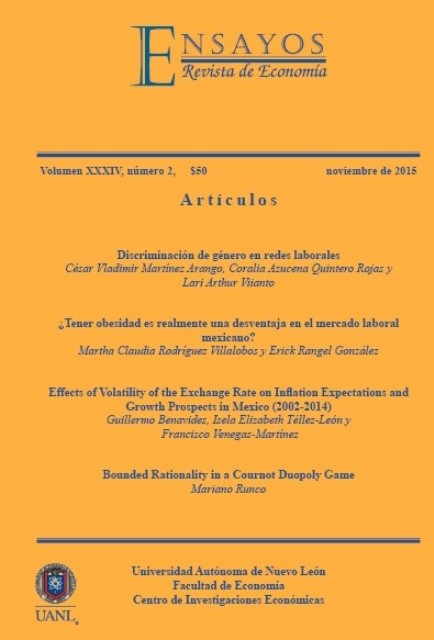Gender discrimination in work networks
Discriminación de género en redes laborales
DOI:
https://doi.org/10.29105/ensayos34.2-1Keywords:
Gender Discrimination, Labor Market, Social Networks, Agent-Based ModelingAbstract
This work circumscribes to the literature of Agent-Based Models (MBA) and its main objective is to analyze the differences in the labor market performance of men and women, under the assumption that there is a cultural difference in the way that society treats each gender. For this purpose, we develop a model of information transfer through a fixed social network. Its nodes correspond to pairs of man and woman in the labor force. This model is used to assess the impact of gender roles on the labor market. Our results from simulations show that, even without salary or job discrimination, gender roles have a negative impact on gender gaps concerning unemployment, participation and the probability of being hired through the network.
Downloads
References
Arendt, H. (2005). La Condición Humana, Estado y Sociedad Vol. 14, Barcelona: Paidós.
Barrufini, M. (2014). “An Agent-Based Simulation of the Swiss Labor Market: an Alternative for Policy Evaluation”. Conference Paper. DOI: https://doi.org/10.18278/jpcs.2.1.4
Becker, G. S.(1957, 1971). The Economics of Discrimination. USA: Chicago University Press.
Becker, G. S. (1965). “A Theory of the Allocation of Time”. The Economic Journal, 75(299), 493–517. DOI: https://doi.org/10.2307/2228949
Berg, N., y Donald L. (2002). ‘‘Measuring the Effect of Sexual Orientation on Income: Evidence of Discrimination?’’. Contemporary Economic Policy, 20(4), 394–414. DOI: https://doi.org/10.1093/cep/20.4.394
Black, D. A., Seth G. S., y Lowell J. T. (2007). ‘‘The Economics of Gay and Lesbian Families’’. The Journal of Economic Perspectives, 21(2), 53–70. DOI: https://doi.org/10.1257/jep.21.2.53
Blandford, J. M. (2003). ‘‘The Nexus of Sexual Orientation and Gender in the Determination of Earnings’’. Industrial and Labor Relations Review, 56(4), 622–42. DOI: https://doi.org/10.1177/001979390305600405
Blinder, A. S. (1973). “Wage Discrimination: Reduced Form and Structural Estimates”. The Journal of Human Resources, 8(4), 436-455. DOI: https://doi.org/10.2307/144855
Burda, M., Hamermesh, D. S. y Weil, P. (2007). “Total Work, Gender and Social Norms”. NBER Working Paper No. 13000. DOI: https://doi.org/10.3386/w13000
Calvó-Armengol, A. (2000). “Job Contact Networks”, Unpublished.
Calvo-Armengol, A. y Jackson, M. (2004). “The Effects of Social Networks on Employment and Inequality”. The American Economic Review, 94(3), 426-454. DOI: https://doi.org/10.1257/0002828041464542
Clain, S. H., y Leppel, K. (2001). ‘‘An Investigation into Sexual Orientation Discrimination as an Explanation for Wage Differences’’. Applied Economics, 33(1), 37–47. DOI: https://doi.org/10.1080/00036840122961
Corbett, C., y Hill, C. (2012). Graduating to a Pay Gap: The Earnings of Women and Men One Year after College Graduation. Washington: American Association of University Women.
Daneshvary, N., Waddopus, J. C., Wimmer, B. S. (2009). “Previous Marriage and the Lesbian Wage Premium”. Industrial Relations, 48(3), 432-453. DOI: https://doi.org/10.1111/j.1468-232X.2009.00567.x
Duval-Hernández, Robert y Orraca-Romano, P. (2009). “A Cohort Analysis of Labor Participation in Mexico, 1987-2009”. IZA Discussion Paper Series No. 4371. DOI: https://doi.org/10.2139/ssrn.1472563
Evangelia, B. (2012). “Global employment Trends for Women”. International Labour Organization Discussion paper.
Encuesta Nacional de Ocupación y Empleo (2012). Indicadores de ocupación y empleo al segundo trimestre de 2012. Disponible en: <http://www3.inegi.org.mx/sistemas/temas/default.aspx?s=est&c=25433&t=1>.
El Banco Mundial (2012). Mujeres tienen menos probabilidades que hombres de participar en el mercado laboral en la mayoría de los países. Disponible en: <http://datos.bancomundial.org/noticias/mujeres_tienen_menos_probabilidades_que_hombres_de_participar_en_el_mercado_laboral_en_la_mayoria_de_los_paises (fecha de publicación: 13 de septiembre de 2012)>.
Fernández, R. (2007). “Alfred Marshall Lecture. Women, Work and Culture”. Journal of the European Economic Association, 5(2-3), 305–332. DOI: https://doi.org/10.1162/jeea.2007.5.2-3.305
García-Bermúdez, K. J. y. Mendoza-Cota, J. E. (2009). “Discriminación Salarial por Género en México”. Problemas del Desarrollo, 40(156), 77-99. DOI: https://doi.org/10.22201/iiec.20078951e.2009.156.7754
Gatti, D. D., Gallegati, M., y Desiderio, S. (2014). The dynamics of the labour market in an agent-based model with financial constraints. En Cristini, A., Fazzari, S., Greenberg, E. y Leoni, R. (Eds.), Cycles, Growth and the Great Recession (117-129). Routledge.
Granovetter, M. S. (1973) “The Strength of Weak Ties”. American Journal of Sociology, 78(6), 1360-1380. DOI: https://doi.org/10.1086/225469
Klawitter, M. M., y Flatt, V. (1998). ‘‘The Effects of State and Local Antidiscrimination Policies on Earnings for Gays and Lesbians’’. Journal of Policy Analysis and Management, 17(4), 658–86. DOI: https://doi.org/10.1002/(SICI)1520-6688(199823)17:4<658::AID-PAM4>3.0.CO;2-P
Kunze, A. (2005). “The Evolution of the Gender Wage Gap”. Labor Economics, 12, 73-97. DOI: https://doi.org/10.1016/j.labeco.2004.02.012
Loury, G. (1977). A Dynamic Theory of Racial Income Differences. En Wallace, P. A. (Ed.), Women, Minorities, and Employment Discrimination. USA: Lexington Books.
Myers, C. A. y Shultz, G. P. (1951). The Dynamics of Labor Markets. New York: Prentice Hall.
Neugart, M. (2006). “Labor market policy evaluation with an agent-based model”. WZB Discussion Paper. DOI: https://doi.org/10.2139/ssrn.917807
Ng, T. S., y Kang, Y. C. (2013). “The inquiry of labor market dynamics in knowledge economies: an agent-based approach”. Systems, Man, and Cybernetics: Systems, 43(2), 416-427. DOI: https://doi.org/10.1109/TSMCA.2012.2195167
Oaxaca, R. (1973). “Male-Female Wage Differentials in Urban Labor Markets”. International Economic Review, 14(3), 693-709. DOI: https://doi.org/10.2307/2525981
O'Neill, J. y O'Neill, D. (2005). “What Do Wage Differentials Tell Us about Labor Market Discrimination?”. NBER Working Paper No. 11240. DOI: https://doi.org/10.3386/w11240
Rees, A y Shultz, G. P. (1970). “Workers in an Urban Labor Market”. American Economic Review, 56, 559-566.
Sanborn, H. (1964). “Pay Differences between Men and Women”, Industrial and Labor Relations Review, 17, 534-550. DOI: https://doi.org/10.1177/001979396401700402
Takács, K., Squazzoni, F., y Bravo, G. (2012). “The network antidote: an agent-based model of discrimination in labor markets”. MKE 2012 Conference, Budapest.
Tassier, T. (2008). “Referral Hiring and Gender Segregation in the Workplace”. Eastern Economic Journal, 34(4), 429-440. DOI: https://doi.org/10.1057/eej.2008.29
Zaiceva, A. y Zimmermann, K. F. (2014). “Children, Kitchen, Church: does ethnicity Matter?”. Review of Economics of the Household, 12(1), 83-103. DOI: https://doi.org/10.1007/s11150-013-9178-9
Downloads
Published
How to Cite
Issue
Section
License
Copyright (c) 2015 César Vladimir Martínez-Arango, Coralia Azucena Quintero-Rojas, Lari Arthur Viianto

This work is licensed under a Creative Commons Attribution 4.0 International License.
















